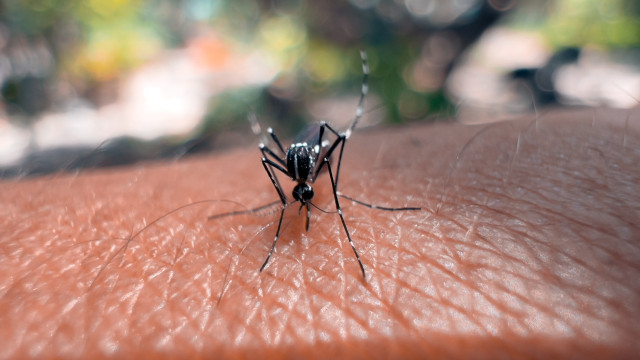




























See Also
See Again
How toxic algal blooms are affecting California’s ecosystems
- Since February, over 140 sea lions have been rescued from Southern California beaches as a catastrophic harmful algae bloom wreaks havoc on local wildlife. Dolphins and birds are also showing signs of illness or turning up lifeless, making this bloom the most devastating in the region’s history. According to John Warner, CEO of the Marine Mammal Care Center, the situation in Los Angeles County is now even worse than in 2023, which was previously considered the worst year on record. Warner explains that the algae produce domoic acid, a toxin that causes seizures, erratic behavior, and lethargy in marine mammals. While sea lions are heavily affected, dolphins are experiencing an even higher mortality rate. What’s driving the rise of toxic algal blooms in California, and what are their far-reaching consequences? Click on to find out.
©
0 / 29 Fotos
Responding to crisis
- The Marine Mammal Care Center in the Los Angeles area and SeaWorld San Diego have reported handling numerous cases of stranded marine animals.
© Getty Images
1 / 29 Fotos
The harmful algae
- Many of these animals are believed to be victims of the harmful algae Pseudo-nitzschia, which has been devastating marine life along the Southern California coast.
© Shutterstock
2 / 29 Fotos
Pseudo-nitzschia
- Pseudo-nitzschia is a genus of marine diatoms that is widely distributed across the oceans. It includes both toxic and non-toxic species, with the harmful varieties producing domoic acid, a neurotoxin that can have devastating effects on marine life and ecosystems.
© Getty Images
3 / 29 Fotos
Pseudo-nitzschia blooms
- These species thrive across diverse temperature ranges, allowing them to inhabit various environments, from open oceans to coastal waters. Blooms of these diatoms are often triggered by factors such as elevated nutrient levels, abundant sunlight, and warmer seawater temperatures.
© Getty Images
4 / 29 Fotos
Pseudo-nitzschia diversity
- The diversity within the Pseudo-nitzschia genus poses considerable difficulties for monitoring. With over 50 identified species, most of which cannot be distinguished using traditional light microscopy, researchers face obstacles in accurately tracking and studying these diatoms.
© Getty Images
5 / 29 Fotos
The neurotoxic threat of domoic acid
- Although many species within the Pseudo-nitzschia genus are non-toxic, roughly half have the ability to produce domoic acid (DA), a powerful neurotoxin.
© Getty Images
6 / 29 Fotos
The neurotoxic threat of domoic acid
- This toxin can accumulate in filter-feeding organisms such as shellfish, finfish, and zooplankton, posing a severe risk to the nervous systems of humans, marine birds, and mammals that consume these contaminated species.
© Getty Images
7 / 29 Fotos
Amnesic shellfish poisoning
- While uncommon in humans, consuming seafood contaminated with domoic acid can lead to a potentially fatal condition known as amnesic shellfish poisoning (ASP). This syndrome is characterized by short-term memory loss and a range of other serious symptoms.
© Getty Images
8 / 29 Fotos
Domoic acid poisoning on the west coast
- Domoic acid poisoning has widespread and devastating effects on marine birds and mammals, particularly along the West Coast. Near-annual Pseudo-nitzschia blooms are a recurring crisis, consistently sickening and killing these animals.
© Getty Images
9 / 29 Fotos
The lethal impact of domoic acid
- "This week, we saw more stranded dolphins (both alive and deceased) than we saw during the major domoic acid (DA) bloom in 2023," staff at the Marine Mammal Care Center stated on March 17, 2025.
© Getty Images
10 / 29 Fotos
The lethal impact of domoic acid
- "Recent testing in SoCal shows increased levels of the algae that produces domoic acid, and we anticipate that it will only get worse in the coming weeks," the statement continued.
© Getty Images
11 / 29 Fotos
The lethal impact of domoic acid
- Domoic acid also poses a severe threat to California sea lions. When these animals consume contaminated fish, the toxin accumulates in their systems, leading to seizures, unpredictable behavior, brain damage, and often death.
© Getty Images
12 / 29 Fotos
Safety advisory amidst algae blooms
- In past significant outbreaks, the neurotoxin appeared to have no harmful effects on fish or pose risks to swimmers. However, authorities have issued warnings to the public, urging them to avoid approaching any stranded marine mammals, which could be suffering from domoic acid poisoning.
© Getty Images
13 / 29 Fotos
Health alert
- The California Department of Public Health has issued a warning advising residents to avoid consuming sport-harvested mussels, clams, or scallops from Santa Barbara County.
© Getty Images
14 / 29 Fotos
Health alert
- The agency cautions that cooking does not neutralize the domoic acid toxin, which can lead to severe symptoms in humans, including loss of balance, impaired muscular coordination, slurred speech, and difficulty swallowing.
© Getty Images
15 / 29 Fotos
Upwelling and algae bloom growth
- National Oceanic and Atmospheric Administration (NOAA) reports that upwelling of water along the coastline plays a crucial role in fostering algae bloom growth. Upwelling is when cold water from the deep wells up and replaces the warmer surface water.
© Getty Images
16 / 29 Fotos
Wind-driven upwelling
- Strong upwelling, frequently observed during spring and summer, is driven by winds that pull cold, nutrient-rich waters from the deep ocean to the surface along the coast. This influx of nutrients creates ideal conditions for algae like Pseudo-nitzschia to thrive and expand along the Southern California coast.
© Getty Images
17 / 29 Fotos
Beyond fire runoff
- Although agencies have expressed concerns about health risks stemming from runoff the LA fires in January, they attribute the ongoing event primarily to the Pseudo-nitzschia algae bloom.
© Getty Images
18 / 29 Fotos
Increasing frequency of algae blooms
- While significant algae blooms have traditionally occurred every four to seven years, locals have observed an increase in their frequency in recent years. This uptick may be attributed to a combination of environmental and climatic factors.
© Getty Images
19 / 29 Fotos
Increasing frequency of algae blooms
- NOAA comments: "Domoic acid is a naturally occurring toxin that has existed for centuries and was first identified in Japan in the late 1950s. Although it wasn’t detected in California until 1991, the prevalence of toxic algal blooms along the Pacific coast has increased dramatically in recent years."
© Getty Images
20 / 29 Fotos
Increasing frequency of algae blooms
- "Researchers say human activities like increased fertilizer use, sewage runoff, and warming waters due to climate change create the types of conditions in which algal blooms like these thrive," NOAA stated.
© Getty Images
21 / 29 Fotos
Climate change’s role
- Dave Bader, a marine biologist at the Marine Mammal Care Center in San Pedro, emphasizes the role climate change plays in the ongoing toxic algal blooms. He explains that human activities, such as ocean acidification and the burning of fossil fuels, have profoundly altered the ocean's chemistry.
© Shutterstock
22 / 29 Fotos
The long-term impact of algal blooms
- Bader warns that if the unprecedented increase in toxic algal blooms persists, future generations may only encounter certain marine mammals through books, as these species face the risk of extinction.
© Getty Images
23 / 29 Fotos
How to respond to stranded marine animals
- The MMCC advises the public to maintain a distance of at least 50 feet (15 meters) from stranded marine animals to avoid causing them additional stress. They encourage individuals to contact the center for professional assistance and support in handling the situation safely.
© Getty Images
24 / 29 Fotos
How to respond to stranded marine animals
- Experts emphasize that interfering with a stranded marine animal or attempting to push it back into the water is the worst action one can take. Such efforts can exacerbate the animal's stress and worsen its condition.
© Getty Images
25 / 29 Fotos
Minimizing stress for stranded marine animals
- Marine experts recommend keeping noise levels as low as possible and maintaining distance from stranded animals by keeping dogs away and avoiding large crowds. These measures help minimize stress on the animal, giving it a better chance to recover while awaiting professional assistance.
© Getty Images
26 / 29 Fotos
Community support needed
- Bader and his team at the Marine Mammal Care Center are working tirelessly to rescue as many sick marine mammals as they can. They are appealing to the community for support, seeking donations and additional resources to sustain their critical efforts during this crisis.
© Getty Images
27 / 29 Fotos
Community support needed
- "We have the opportunity to make a meaningful difference and embrace change," said Dave Bader. He emphasizes the importance of community support, urging people to assist the Marine Mammal Care Center during this critical time. Sources: (NOAA) (MMCC) (FOX News) (Harmful Algae Site)
© Getty Images
28 / 29 Fotos
How toxic algal blooms are affecting California’s ecosystems
- Since February, over 140 sea lions have been rescued from Southern California beaches as a catastrophic harmful algae bloom wreaks havoc on local wildlife. Dolphins and birds are also showing signs of illness or turning up lifeless, making this bloom the most devastating in the region’s history. According to John Warner, CEO of the Marine Mammal Care Center, the situation in Los Angeles County is now even worse than in 2023, which was previously considered the worst year on record. Warner explains that the algae produce domoic acid, a toxin that causes seizures, erratic behavior, and lethargy in marine mammals. While sea lions are heavily affected, dolphins are experiencing an even higher mortality rate. What’s driving the rise of toxic algal blooms in California, and what are their far-reaching consequences? Click on to find out.
©
0 / 29 Fotos
Responding to crisis
- The Marine Mammal Care Center in the Los Angeles area and SeaWorld San Diego have reported handling numerous cases of stranded marine animals.
© Getty Images
1 / 29 Fotos
The harmful algae
- Many of these animals are believed to be victims of the harmful algae Pseudo-nitzschia, which has been devastating marine life along the Southern California coast.
© Shutterstock
2 / 29 Fotos
Pseudo-nitzschia
- Pseudo-nitzschia is a genus of marine diatoms that is widely distributed across the oceans. It includes both toxic and non-toxic species, with the harmful varieties producing domoic acid, a neurotoxin that can have devastating effects on marine life and ecosystems.
© Getty Images
3 / 29 Fotos
Pseudo-nitzschia blooms
- These species thrive across diverse temperature ranges, allowing them to inhabit various environments, from open oceans to coastal waters. Blooms of these diatoms are often triggered by factors such as elevated nutrient levels, abundant sunlight, and warmer seawater temperatures.
© Getty Images
4 / 29 Fotos
Pseudo-nitzschia diversity
- The diversity within the Pseudo-nitzschia genus poses considerable difficulties for monitoring. With over 50 identified species, most of which cannot be distinguished using traditional light microscopy, researchers face obstacles in accurately tracking and studying these diatoms.
© Getty Images
5 / 29 Fotos
The neurotoxic threat of domoic acid
- Although many species within the Pseudo-nitzschia genus are non-toxic, roughly half have the ability to produce domoic acid (DA), a powerful neurotoxin.
© Getty Images
6 / 29 Fotos
The neurotoxic threat of domoic acid
- This toxin can accumulate in filter-feeding organisms such as shellfish, finfish, and zooplankton, posing a severe risk to the nervous systems of humans, marine birds, and mammals that consume these contaminated species.
© Getty Images
7 / 29 Fotos
Amnesic shellfish poisoning
- While uncommon in humans, consuming seafood contaminated with domoic acid can lead to a potentially fatal condition known as amnesic shellfish poisoning (ASP). This syndrome is characterized by short-term memory loss and a range of other serious symptoms.
© Getty Images
8 / 29 Fotos
Domoic acid poisoning on the west coast
- Domoic acid poisoning has widespread and devastating effects on marine birds and mammals, particularly along the West Coast. Near-annual Pseudo-nitzschia blooms are a recurring crisis, consistently sickening and killing these animals.
© Getty Images
9 / 29 Fotos
The lethal impact of domoic acid
- "This week, we saw more stranded dolphins (both alive and deceased) than we saw during the major domoic acid (DA) bloom in 2023," staff at the Marine Mammal Care Center stated on March 17, 2025.
© Getty Images
10 / 29 Fotos
The lethal impact of domoic acid
- "Recent testing in SoCal shows increased levels of the algae that produces domoic acid, and we anticipate that it will only get worse in the coming weeks," the statement continued.
© Getty Images
11 / 29 Fotos
The lethal impact of domoic acid
- Domoic acid also poses a severe threat to California sea lions. When these animals consume contaminated fish, the toxin accumulates in their systems, leading to seizures, unpredictable behavior, brain damage, and often death.
© Getty Images
12 / 29 Fotos
Safety advisory amidst algae blooms
- In past significant outbreaks, the neurotoxin appeared to have no harmful effects on fish or pose risks to swimmers. However, authorities have issued warnings to the public, urging them to avoid approaching any stranded marine mammals, which could be suffering from domoic acid poisoning.
© Getty Images
13 / 29 Fotos
Health alert
- The California Department of Public Health has issued a warning advising residents to avoid consuming sport-harvested mussels, clams, or scallops from Santa Barbara County.
© Getty Images
14 / 29 Fotos
Health alert
- The agency cautions that cooking does not neutralize the domoic acid toxin, which can lead to severe symptoms in humans, including loss of balance, impaired muscular coordination, slurred speech, and difficulty swallowing.
© Getty Images
15 / 29 Fotos
Upwelling and algae bloom growth
- National Oceanic and Atmospheric Administration (NOAA) reports that upwelling of water along the coastline plays a crucial role in fostering algae bloom growth. Upwelling is when cold water from the deep wells up and replaces the warmer surface water.
© Getty Images
16 / 29 Fotos
Wind-driven upwelling
- Strong upwelling, frequently observed during spring and summer, is driven by winds that pull cold, nutrient-rich waters from the deep ocean to the surface along the coast. This influx of nutrients creates ideal conditions for algae like Pseudo-nitzschia to thrive and expand along the Southern California coast.
© Getty Images
17 / 29 Fotos
Beyond fire runoff
- Although agencies have expressed concerns about health risks stemming from runoff the LA fires in January, they attribute the ongoing event primarily to the Pseudo-nitzschia algae bloom.
© Getty Images
18 / 29 Fotos
Increasing frequency of algae blooms
- While significant algae blooms have traditionally occurred every four to seven years, locals have observed an increase in their frequency in recent years. This uptick may be attributed to a combination of environmental and climatic factors.
© Getty Images
19 / 29 Fotos
Increasing frequency of algae blooms
- NOAA comments: "Domoic acid is a naturally occurring toxin that has existed for centuries and was first identified in Japan in the late 1950s. Although it wasn’t detected in California until 1991, the prevalence of toxic algal blooms along the Pacific coast has increased dramatically in recent years."
© Getty Images
20 / 29 Fotos
Increasing frequency of algae blooms
- "Researchers say human activities like increased fertilizer use, sewage runoff, and warming waters due to climate change create the types of conditions in which algal blooms like these thrive," NOAA stated.
© Getty Images
21 / 29 Fotos
Climate change’s role
- Dave Bader, a marine biologist at the Marine Mammal Care Center in San Pedro, emphasizes the role climate change plays in the ongoing toxic algal blooms. He explains that human activities, such as ocean acidification and the burning of fossil fuels, have profoundly altered the ocean's chemistry.
© Shutterstock
22 / 29 Fotos
The long-term impact of algal blooms
- Bader warns that if the unprecedented increase in toxic algal blooms persists, future generations may only encounter certain marine mammals through books, as these species face the risk of extinction.
© Getty Images
23 / 29 Fotos
How to respond to stranded marine animals
- The MMCC advises the public to maintain a distance of at least 50 feet (15 meters) from stranded marine animals to avoid causing them additional stress. They encourage individuals to contact the center for professional assistance and support in handling the situation safely.
© Getty Images
24 / 29 Fotos
How to respond to stranded marine animals
- Experts emphasize that interfering with a stranded marine animal or attempting to push it back into the water is the worst action one can take. Such efforts can exacerbate the animal's stress and worsen its condition.
© Getty Images
25 / 29 Fotos
Minimizing stress for stranded marine animals
- Marine experts recommend keeping noise levels as low as possible and maintaining distance from stranded animals by keeping dogs away and avoiding large crowds. These measures help minimize stress on the animal, giving it a better chance to recover while awaiting professional assistance.
© Getty Images
26 / 29 Fotos
Community support needed
- Bader and his team at the Marine Mammal Care Center are working tirelessly to rescue as many sick marine mammals as they can. They are appealing to the community for support, seeking donations and additional resources to sustain their critical efforts during this crisis.
© Getty Images
27 / 29 Fotos
Community support needed
- "We have the opportunity to make a meaningful difference and embrace change," said Dave Bader. He emphasizes the importance of community support, urging people to assist the Marine Mammal Care Center during this critical time. Sources: (NOAA) (MMCC) (FOX News) (Harmful Algae Site)
© Getty Images
28 / 29 Fotos
How toxic algal blooms are affecting California’s ecosystems
Exploring the causes and consequences of the latest outbreak
© Getty Images
Since February, over 140 sea lions have been rescued on Southern California beaches as a catastrophic harmful algae bloom takes its toll. Dolphins and birds are also appearing sick or lifeless, making this bloom the most devastating in the region’s history.
According to John Warner, CEO of the Marine Mammal Care Center, the situation in Los Angeles County is even worse than 2023, which was previously considered the most severe year on record. Warner explains that the algae produce domoic acid, a toxin that causes seizures, erratic behavior, and lethargy in marine mammals. While sea lions are heavily affected, dolphins experience an even higher mortality rate.
What’s driving the rise of toxic algal blooms in California, and what are the far-reaching consequences? Click on to find out.
RECOMMENDED FOR YOU




































MOST READ
- Last Hour
- Last Day
- Last Week








